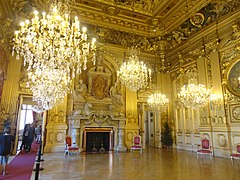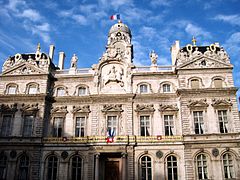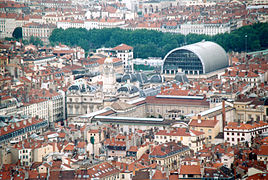Hotel de Ville (Lyon)
| Hotel de Ville de Lyon | |
|---|---|
 |
|
| Data | |
| place | Lyon |
| architect | Simon Maupin , Girard Desargues , Jules Hardouin-Mansart |
| Architectural style | City Hall, Hôtel de Ville |
| Construction year | 1646-1672 |
| Coordinates | 45 ° 46 '4 " N , 4 ° 50' 6" E |
The city hall ( Hôtel de ville ) of Lyon is one of the most impressive historical buildings in the city and is located between the Terreaux and the Place de la comédie opposite the opera . It has belonged to the Monuments historiques since July 12, 1886 .
Today the city council meets here 10 times a year.
history
Construction of the town hall
In the 17th century, the Presqu'île became the city center and the Terreaux square was now in the heart of the city: the square was paved and upgraded with the construction of the town hall (between 1645 and 1672 by Simon Maupin and Gérard Desargues .)
Before the town hall was built, the community used the Hôtel de la Couronne (now the Musée de l'Imprimerie ) on rue de la Poulaillerie. This parish hall was not accepted by the politics and administration of a city like Lyon. On February 6, 1646, the Hôtel de la Couronne was auctioned for 52,000 livres; the money was used to finance today's town hall.
On March 8, 1646, Simon Maupin was commissioned by the city council to draw up the plans. He was designed by the king's architect and especially by Girard Desargues . Today it is difficult to determine which construction phase is to be assigned to which of the three men; in any case, Maupin seems to have played the most important role.
On May 8, 1646, the king approves the building with a letter and a seal. The work officially begins on September 5th of the year, on honorary birthday of Louis XIV. On December 10th, Simon Maupin resigns as head of building (fr: voyer de la ville ); his son Ennemond follows him. However, this will be eliminated on January 3rd. Several execution problems arise, but these are probably due to the lack of funding. After 26 years of construction, the work was completed in 1672.
After completion
On September 13, 1674, the town hall fell victim to a fire. The fire destroyed the great hall and damaged the bell tower, the attic and the roof. The grand staircase, the archive and the Heinrich IV hall were also damaged. The city asked Thomas Blanchet to restore the town hall, but he did not have the funds.
Finally, on October 3, 1699, the decision was made to restore the town hall. The work began in 1701 and ended in 1703. The work was carried out according to the plans of Jules Hardouin-Mansart and his student Robert de Cotte . The measures served to restore and modernize the damaged buildings.
In 1792, as a result of the revolution , the half-relief in the middle of the facade, which depicted Louis XIV as a rider, was removed and only brought back to the old place at the time of the restoration by the good King Heinrich . The statue is the work of the sculptor Jean-François Legendre-Héral in 1829.
On July 14, 1803, the town hall was destroyed a second time by fire. It was not renovated until the Second Empire, together with other works, under the then city architect Louis Cécile Flacheron .
Particularly worth seeing
ground floor
- The lower courtyard after the entrance gallery. This is followed by the upper courtyard (court of honor), separated by an arcade.
- The grand staircase in the southwest part of the upper courtyard with the decoration by Thomas Blanchet (between 1658 and 4667). Particularly noteworthy is the carpet wall depicting the great fire of Lugdunum during the reign of Emperor Nero . Historical wall paintings.
- The transitions (connections between the buildings)
1. floor
- Mayor's office: It is located in the north wing of the east facade of the town hall opposite the opera. The room is adorned with silk work from Lyon, paneling, woodwork and imperial coats of arms, two large ceiling paintings by Louis Janmot and a fireplace ("Allégorie du Suffrage universel" by Paul Doumer ).
- Hall of the former archive: The only vaulted hall on the first floor with Dutch copper chandeliers and paintings from the Second Empire .
- Salon de la Conservation ( supervisory office ): ceiling painting by Thomas Blanchet (1668/1669)
- Wappensaal: The portraits of the deputy mayors used to be attached here, but they were destroyed by the fire and now replaced by their coats of arms (18th century).
- Consulate room: remarkable fireplace
- Room Henri IV: Decoration from 1670 to 1675. Ceiling painting to glorify the Sun King.
- Council room: It is one of the most beautiful halls in the town hall, accessible via the grand staircase. It has an area of 325 m² and was destroyed in the fire of 1674. It was renovated in 1717 by J. Hardouin-Mansart using woodwork and painted fabrics, although the architect originally wanted to use marble and stone. Also of note is a bronze relief showing the founding of Lyon by Lucius Munatius Plancus . It is also called Salon Justin Godart (former mayor "between the nations" after World War II ).
- The red rooms: Here you can find medallions from the various stages of silk production. On a fireplace is a copy of a statue of Marie Leczinzska as Juno by Guillaume Coustou from the Louvre
2nd Floor
- View of the tower
- Access to the bell tower of the town hall, which with 65 bells is said to have one of the largest carillons in Europe.
Views
In the courtyard of the Musée des Beaux-Arts (Lyon) , mosaic of the town hall
The town hall during the siege in 1793.
View of the town hall from Fourvière .
“Play of light on the facades”, Terreaux
The main courtyard of the Opera from
City hall in the film
- The day that changed everything by Gaël Morel (2007)
Transport links
There is a station of the Métro Lyon (Hôtel de Ville - Louis Pradel).
Web links
- Cityscapes
- History of the Hôtel de Ville de Lyon
- Pdf: Model of the Hôtel de ville de Lyon Extract from the Museum of the History of Lyon .
- Exhibition at the Musée Gadagne
Individual evidence
- ↑ http://www.culture.gouv.fr/
- ↑ a b www.lyon.fr ( Memento of the original from April 23, 2016 in the Internet Archive ) Info: The archive link was inserted automatically and has not yet been checked. Please check the original and archive link according to the instructions and then remove this notice.
- ↑ His role was unknown for a long time, but is now considered proven.
- ↑ a b c d e f g h i Tony Desjardins, Histoire de l'Hôtel-de-Ville de Lyon depuis l'époque de sa construction jusqu'à nos jours , Ed. Perrin, 1871-01-01; (to be found here)
- ↑ a b c d e f g h i j L'Hôtel de Ville, on the Patrimoine Lyon.org page
- ↑ a b Debidour, Laferrere, Lyon et ses environs , Ed. Arthaud, 02/10/1990, ISBN 978-2-7003-0115-1 .
- ↑ Jacques Louis Delpal, Merveille du Lyonnais et du Beaujolais , Ed. Martinière, January 2, 1996, ISBN 978-2-7324-2081-3 .















